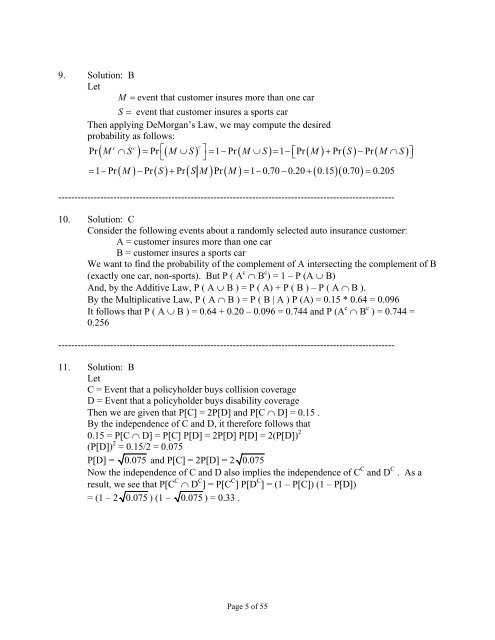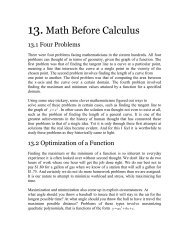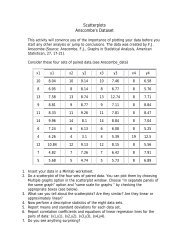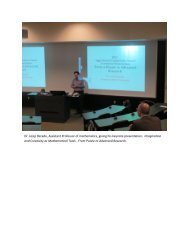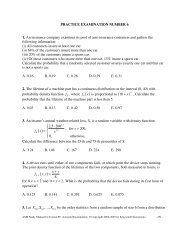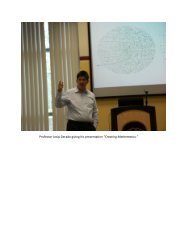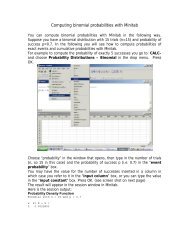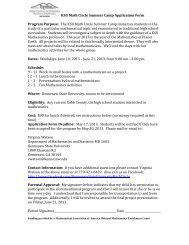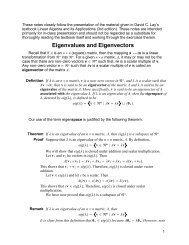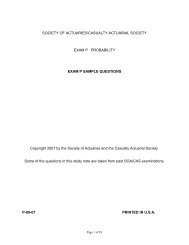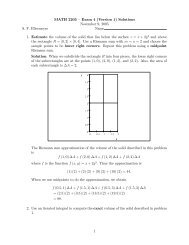EXAM P SAMPLE SOLUTIONS
EXAM P SAMPLE SOLUTIONS
EXAM P SAMPLE SOLUTIONS
You also want an ePaper? Increase the reach of your titles
YUMPU automatically turns print PDFs into web optimized ePapers that Google loves.
9. Solution: B<br />
Let<br />
M = event that customer insures more than one car<br />
S = event that customer insures a sports car<br />
Then applying DeMorgan’s Law, we may compute the desired<br />
probability as follows:<br />
c c<br />
c<br />
Pr ( M ∩ S ) = Pr ⎡( M ∪ S) ⎤ = 1−Pr( M ∪ S) = 1− ⎡Pr ( M) + Pr ( S) −Pr ( M ∩S)<br />
⎤<br />
⎣ ⎦<br />
⎣ ⎦<br />
= 1−Pr M − Pr S + Pr S M Pr M = 1−0.70 − 0.20 + 0.15 0.70 = 0.205<br />
( ) ( ) ( ) ( ) ( )( )<br />
--------------------------------------------------------------------------------------------------------<br />
10. Solution: C<br />
Consider the following events about a randomly selected auto insurance customer:<br />
A = customer insures more than one car<br />
B = customer insures a sports car<br />
We want to find the probability of the complement of A intersecting the complement of B<br />
(exactly one car, non-sports). But P ( A c ∩ B c ) = 1 – P (A ∪ B)<br />
And, by the Additive Law, P ( A ∪ B ) = P ( A) + P ( B ) – P ( A ∩ B ).<br />
By the Multiplicative Law, P ( A ∩ B ) = P ( B | A ) P (A) = 0.15 * 0.64 = 0.096<br />
It follows that P ( A ∪ B ) = 0.64 + 0.20 – 0.096 = 0.744 and P (A c ∩ B c ) = 0.744 =<br />
0.256<br />
--------------------------------------------------------------------------------------------------------<br />
11. Solution: B<br />
Let<br />
C = Event that a policyholder buys collision coverage<br />
D = Event that a policyholder buys disability coverage<br />
Then we are given that P[C] = 2P[D] and P[C ∩ D] = 0.15 .<br />
By the independence of C and D, it therefore follows that<br />
0.15 = P[C ∩ D] = P[C] P[D] = 2P[D] P[D] = 2(P[D]) 2<br />
2<br />
(P[D]) = 0.15/2 = 0.075<br />
P[D] = 0.075 and P[C] = 2P[D] = 2 0.075<br />
Now the independence of C and D also implies the independence of C C and D C . As a<br />
result, we see that P[C C ∩ D C ] = P[C C ] P[D C ] = (1 – P[C]) (1 – P[D])<br />
= (1 – 2 0.075 ) (1 – 0.075 ) = 0.33 .<br />
Page 5 of 55


